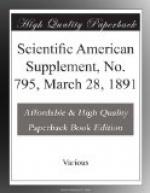(To be continued.)
* * * * *
HOW TO PREVENT HAY FEVER.
By ALEXANDER RIXA, M.D., New York.
In the May (1890) number of the Therapeutic Gazette I furnished some contribution to the “Treatment of Hay Fever.” I reported therein a favorable result in the treatment of this mysterious disease in the experience of my last year’s cases.
My experience of this year is far more gratifying, and worthy of receiving a wide publicity.
I treated six cases in all, four of which have been habitual for years to hay fever proper without complications, while the other two used to have the disease aggravated with reflex asthma and bronchial catarrh. I succeeded in preventing the outbreak of the disease in every individual case. The treatment I applied was very simple, and consisted of the following:
From the fact that I had known all my patients from previous years, I ordered them to my office two weeks before the usual onset of the disease. I advised them to irrigate the nose with a warm solution of chloride of sodium four times a day—morning, noon, evening, and on retiring; and, a few minutes after the cleansing of the parts, had the nares thoroughly sprayed with peroxide of hydrogen and c.p. glycerin, half and half. Those subject to a conjunctivitis I prescribed a two per cent. solution of boric acid as a wash. At this period no internal medication was given, but three days previous to the usual onset of the disease I prescribed phenacetin and salol, five grains of each three times a day.
On the respective expected days, to the great surprise of all the members concerned successively, who have been in the habit of getting the disease almost invariably at a certain date, no hay fever symptoms appeared, though everyone had been the victim of the disease for a great number of years, varying from five to nineteen years’ standing.
It is self-understood that this treatment was kept up all through the season, and, as no symptoms developed, the applications were reduced, toward the termination, to twice and once a day. The internal medication, however, was stopped after the expiration of the first week, and all the patients could attend to their various respective vocations, something they never have been able to do in previous years.
In two cases, though no nasal symptoms developed, about two weeks after the calculated onset, slight symptoms of asthma made their appearance. However, I could easily suppress them at this time with the aid of the hand atomizer and ozonizer, a very ingenious little apparatus, of which I gave a thorough description in my last year’s article. I used the ozone inhalations every four hours, in connection with the internal administration of the following prescription:
Rx Iodide of ammonia, 8;
Fl. ex. quebracho, 30;
Fl. ex. grindelia robusta, 15;
Tr. lobelia, 12;
Tr. belladonna, 8;
Syr. pruni, virg., q.s., ad 120.




